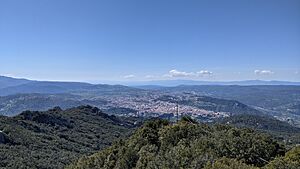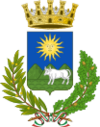Nuoro facts for kids
Quick facts for kids
Nuoro
Nùgoro (Sardinian)
|
|||
|---|---|---|---|
| Comune di Nuoro | |||

View of Nuoro
|
|||
|
|||
| Country | Italy | ||
| Region | Sardinia | ||
| Province | Nuoro (NU) | ||
| Frazioni | Lollove | ||
| Area | |||
| • Total | 192.27 km2 (74.24 sq mi) | ||
| Elevation | 554 m (1,818 ft) | ||
| Population
(January 1, 2012)
|
|||
| • Total | 36,347 | ||
| • Density | 189.041/km2 (489.615/sq mi) | ||
| Demonym(s) |
|
||
| Time zone | UTC+1 (CET) | ||
| • Summer (DST) | UTC+2 (CEST) | ||
| Postal code |
08100
|
||
| Dialing code | 0784 | ||
| Patron saint | Santa Maria della Neve | ||
| Saint day | August 5 | ||
Nuoro (pronounced like NOO-oh-roh) is a city in central Sardinia, Italy. It sits on the slopes of Mount Ortobene. Nuoro is the main city of its province and has about 36,000 people. This makes it the sixth-largest city in Sardinia. One of its small towns, Lollove, is known as one of "The most beautiful villages of Italy."
Nuoro is famous for being the hometown of many talented artists. These include writers, poets, painters, and sculptors. The city has some of the most important museums in Sardinia. It is seen as a major cultural hub in the region. People sometimes call it the "Sardinian Athens." Nuoro is also where Grazia Deledda was born. She was the only Italian woman to win the Nobel Prize in Literature in 1926.
Contents
History of Nuoro
Ancient Times in Nuoro
The first signs of people living in the Nuoro area go back a very long time. We find rock-cut tombs called "Domus de janas" from about 3,000 BC. Even older pottery pieces from around 3,500 BC have been found.
This area was also a big center for the Nuragic civilization. This ancient culture lived in Sardinia from about 1500 BC to 250 BC. More than 30 Nuragic sites have been found near Nuoro. One village had about 800 huts!
Roman and Medieval Nuoro
A Roman road once passed through Nuoro. It connected important cities like Cagliari and Olbia. The way people speak Sardinian in Nuoro today shows this Roman past. The local Nuorese Sardinian is thought to be the oldest form of the language.
After the Roman Empire fell, different groups ruled Sardinia. These included the Vandals and then the Byzantines. During the Middle Ages, Nuoro was a small village called Nugor. It grew to over 1,000 people by the 13th century. However, in the late 1600s, hunger and sickness hit the town hard.
Modern Nuoro
Later, Nuoro became part of the Kingdom of Sardinia. It grew into an important administrative center. In 1836, it was officially given the title of "city."
Climate in Nuoro
Nuoro has a mild climate. The weather box below shows the average temperatures and rainfall. It helps us understand what the weather is usually like throughout the year in Nuoro.
| Climate data for Nuoro (1981-2010) | |||||||||||||
|---|---|---|---|---|---|---|---|---|---|---|---|---|---|
| Month | Jan | Feb | Mar | Apr | May | Jun | Jul | Aug | Sep | Oct | Nov | Dec | Year |
| Mean daily maximum °C (°F) | 9.7 (49.5) |
10.2 (50.4) |
13.2 (55.8) |
15.9 (60.6) |
21.7 (71.1) |
27.8 (82.0) |
32.9 (91.2) |
32.0 (89.6) |
26.1 (79.0) |
21.2 (70.2) |
14.6 (58.3) |
10.4 (50.7) |
19.6 (67.3) |
| Mean daily minimum °C (°F) | 3.4 (38.1) |
3.3 (37.9) |
4.9 (40.8) |
6.8 (44.2) |
10.8 (51.4) |
14.8 (58.6) |
18.2 (64.8) |
18.7 (65.7) |
15.3 (59.5) |
12.0 (53.6) |
7.4 (45.3) |
4.5 (40.1) |
10.0 (50.0) |
| Average precipitation mm (inches) | 73.9 (2.91) |
56.5 (2.22) |
52.3 (2.06) |
65.8 (2.59) |
40.7 (1.60) |
20.4 (0.80) |
9.5 (0.37) |
20.6 (0.81) |
47.0 (1.85) |
61.0 (2.40) |
75.7 (2.98) |
91.2 (3.59) |
614.6 (24.20) |
| Source: trentennio-1981-2010/ Climatologia della Sardegna per il trentennio 1981-2010 | |||||||||||||
Culture in Nuoro
ISRE: Studying Sardinian Life
Since 1972, Nuoro has been home to the Istituto superiore regionale etnografico (ISRE). This is an organization that studies and records the social and cultural life of Sardinia. It looks at both old traditions and new changes. ISRE runs museums and libraries. It also hosts national and international events, like:
- The Sardinia International Ethnographic Film Festival (SIEFF)
- The Italian Biennial Festival of Ethnography (ETNU)
Museums to Explore
Nuoro has several interesting museums:
- Sardinian Ethnographic Museum: Learn about Sardinian traditions and daily life.
- Grazia Deledda's Museum: Dedicated to the famous Nobel Prize-winning writer.
- M.A.N., Museo d’Arte Provincia di Nuoro: A modern art museum.
- National Archaeological Museum of Nuoro: Discover ancient artifacts from the area.
- Museo Ciusa: A museum honoring Francesco Ciusa and other artists.
- Spazio Ilisso
- Museum of Ceramics: See beautiful ceramic artworks.
Important Monuments and Sites
Nuoro has many historical places to visit:
- Cathedral of Our Lady of the Snows: A beautiful church.
- Piazza Sebastiano Satta: A public square.
- Chiesa di Nostra Signora delle Grazie
- Chiesa della Solitudine
- The Redeemer's statue: A 7-meter tall bronze statue on Monte Ortobene. It was put there on August 29, 1901.
- Nuraghe Ugolio: An ancient Nuragic structure.
- Chiesa di San Carlo: A church built in the 1600s. It has a copy of Francesco Ciusa's famous artwork, La madre dell'ucciso.
- Sas Birghines: Ancient rock-cut tombs called Domus de Janas on Monte Ortobene.
- Sanctuary Madonna of Montenero: A religious site on Monte Ortobene.
Language of Nuoro
Besides Italian, the traditional language spoken in Nuoro is Sardinian. Specifically, it's the Logudorese-Nuorese type of Sardinian.
Unique Food in Nuoro
Nuoro is home to one of the rarest pastas in the world, called su filindeu. Its name means "the threads of God" in Sardinian. Only women from one family in Nuoro make this pasta. The recipe has been passed down through many generations.
Getting Around Nuoro
Roads
Nuoro is connected by important roads like the SS 131 DCN, SS 129, and SS 389. These roads link Nuoro to other cities and towns.
Buses
ARST (Azienda Regionale Sarda Trasporti) offers regular bus services. You can travel to Cagliari, Sassari, Olbia, and many smaller towns in the region. Other private bus companies also connect Nuoro to various cities and airports on the island.
Trains
You can travel by train from Nuoro to Macomer using the Ferrovie della Sardegna line.
Local Transport
ATP Nuoro's bus system provides transportation within the city itself.
Famous People from Nuoro
Many notable people have come from Nuoro:
- Sebastiano Satta (1867–1914): A well-known poet and lawyer.
- Grazia Deledda (1871–1936): A famous writer who won the Nobel Prize.
- Francesco Ciusa (1883–1949): A talented sculptor who won an award at the Venice Biennale.
- Adelasia Cocco (1885–1983): A health officer in Nuoro. She might have been the first female doctor in Italy.
- Attilio Deffenu (1890–1918): A leader in workers' rights.
- Salvatore Satta (1902–1975): A legal expert and writer.
- Sebastiano Mannironi (1930–2015): An athlete who won a medal at the Olympic Games.
- Franco Oppo (1935–2016): A composer.
- Marcello Fois (born 1960): A writer.
- Flavio Manzoni (born 1967): A car designer.
- Gianfranco Zola (born 1966): A famous footballer.
- Salvatore Sirigu (born 1987): Another well-known footballer.
Twin Towns
Nuoro has special friendships with these towns:
Images for kids
See also
 In Spanish: Nuoro para niños
In Spanish: Nuoro para niños









